Among diving pioneers there were inventors who, for a different sequence of events, were excluded in a kind of lower category; let’s say, to use a euphemism, the series B of diving. Among them, Georges Herail is wrongly inserted; a brilliant but unfortunate creator and producer of a regulator with all advantages of the Cousteau-Gagnan one, but with a different technical approach.
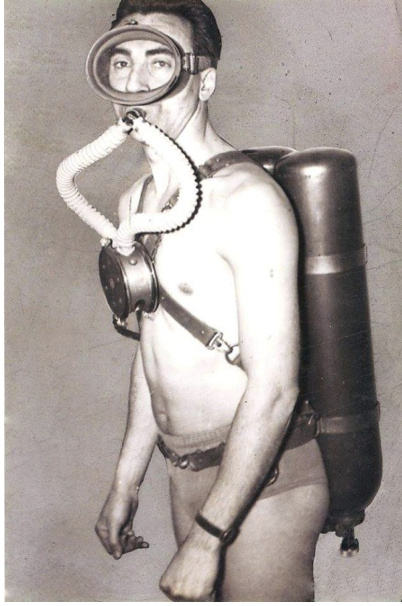
Georges Herail with one Ventral Poumondeau apparatus
Herail was born in France on Aprile 27, 1925 in Serignan (Hérault) village, a small town where he will follow his school path until his technical training. In 1945, he begins his professional career as industrial designer in a glider’s manufacturer and, in 1946, he is employed at the engineering department of the "South-Aviation" in Blagnac. Here, Herail manages several projects, acquiring a good knowledge of the aviation sector. This prerogative will allow him to appreciate the careful and selective manufacturing quality of the production of the aviation sector, which will be very useful to him in the future.

Exploded diagram of double-membrane ventral regulator
Diving passion and patents’ registration
Besides his field of professional competences, Georges is a diving real passionate. This passion will take him to become a constant member of the Toulouse Sub-Aquatic Club, perfect place to begin to study the functioning principles of diving self-breathing systems. His rigid discipline and professional capabilities soon allow him to deposit, in 1953, his first patent for an "autonomous diving system” which foresaw one, two or three steel or light alloy bottles with a volume of 6-7 liters, containing compressed air, at an operating pressure of 165 bar. This system was designed with stages placed in the lower part of the apparatus and with the regulator protected by a metal protection installed in the higher part. To be more specific: Herail’s regulator is characterized by a single stage with two parallel membranes, situated perpendicular to the diver’s back, at the same level of the exhalation valve. This unusual configuration allowed to compensate the difference of the hydrostatic pressure between the inhalation and exhalation phase. With regards to the pressure reduction and the hydrostatic balance, these come by means of two levers (one for each membrane). The regulator is equipped with two corrugated hoses with annular circuit for breathing, connected to a mouthpiece and a duckbill exhalation valve. There is also a safety device which allows to "inflate a possible floating life jacket ", which automatically lifts the diver when the bottle pressure decreases below a certain value, or with a voluntary diver’s operation.
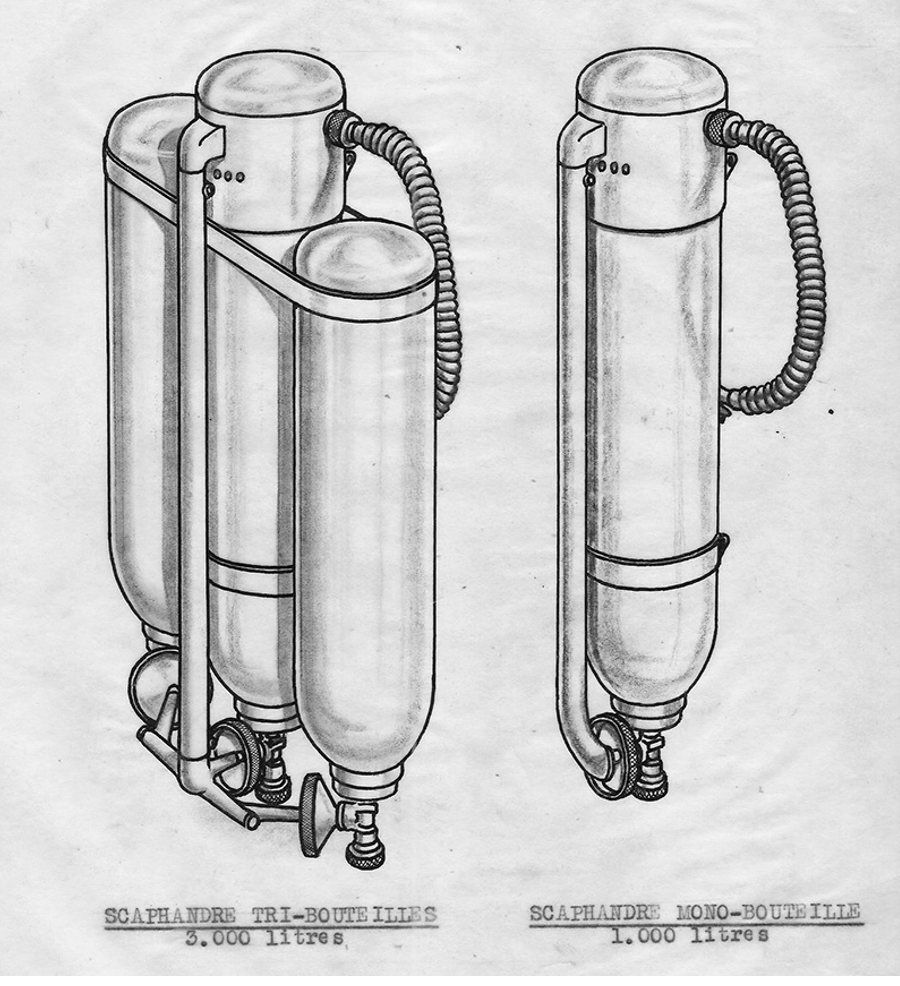
Drawing of the first autonomous diving systems of George Heiral
In 1954, Heiral opens his own activity and begins to produce his first diving breathing systems. These systems will be simply named " G.H. autonomous diving system .. " followed by a specific count as improvements are made (for example, G.H. 05 or G.H. 08), where the "G.H." initials stand for Georges Herail; as “C.G. 45" stood for 1945 Cousteau – Gagnan.
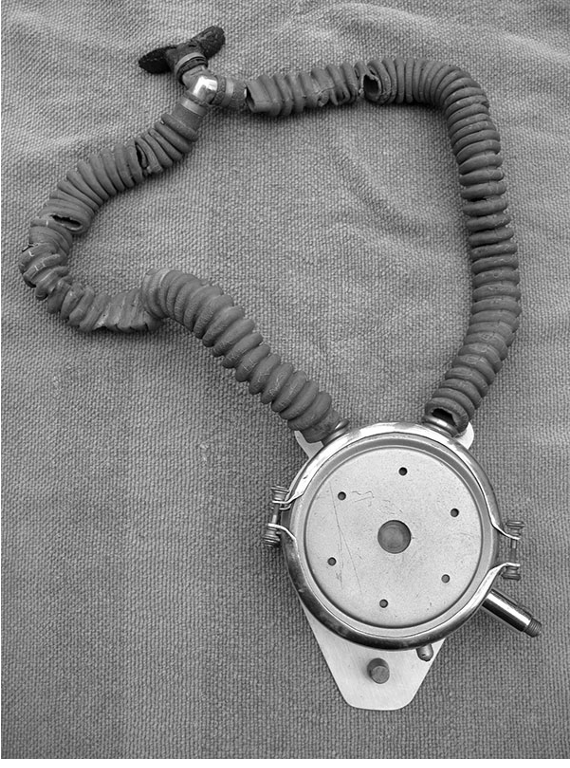
Double membrane ventral regulator
In the same year, he registers a second patent, although it is only an improvement of his first system, in which he explains that the exhalation valve must be placed exactly in the middle of the two membranes. In 1954, always as an enhancement of this system, he deposited a third patent, a device to change air distribution, that is a bypass which allows, alternatively, to supply or the autonomous apparatus or a surface hose. After all these efforts, the time has come to consolidate what done until now and, in 1955, Heiral registers his "POUMONDEAU brand (poumon d'eau that is water lung) , the ideal autonomous system for diving activities".
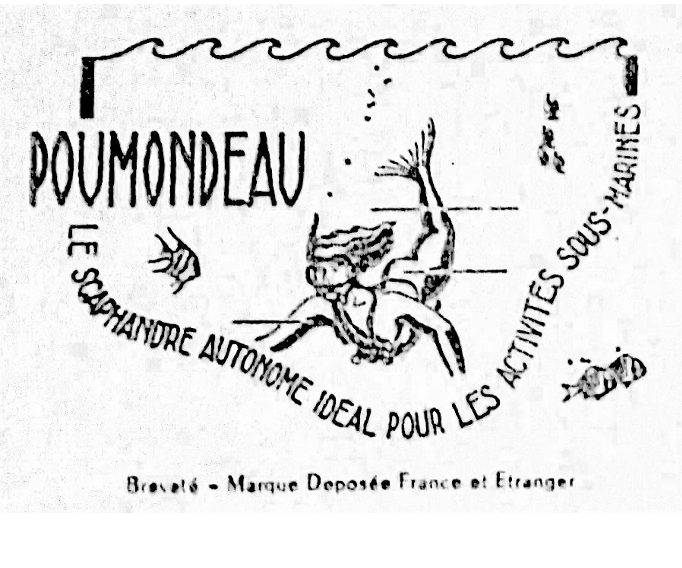
Poumondeau brand
The conflict with Cousteau
Since 1953, Spirotechnique sent an official warning to Herail, accusing him of having made some forgeries of Cousteau – Gagnan autonomous systems. At the beginning, they only wanted to obtain a "friendly" termination of Herail production of his system; in 1956, because of this continuous success, a new letter from Spirotechnique informs his of the decision to take him to court with a legal action.
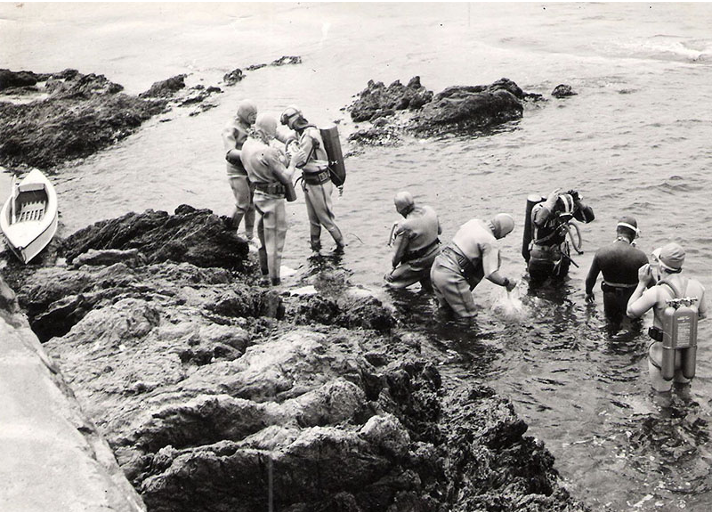
Subacquei equipaggiati con attrezzature Poumondeau di differenti modelli.
One feature is that the announced reclaim and procedure were started, but not under the name of Spirotechnique but personally to Commander Cousteau who, in 1958, he will see his file rejected with the reason of groundlessness.
The different Poumondeau models
All models have the common feature of the manufacturing quality in the spirit of the avionics industry. Bottles, protection and all external metallic parts of the systems had anodized treatments in a shimmering metallic color.
The Dorsal Poumondeau
This system is composed of a single or double tanks with a volume of 8 or 12 liters, with a filling pressure of 160 or 200 bar. The system was worn in the back with valves positioned downwards and the regulator fixed in the front, with belts at the diver’s chest.
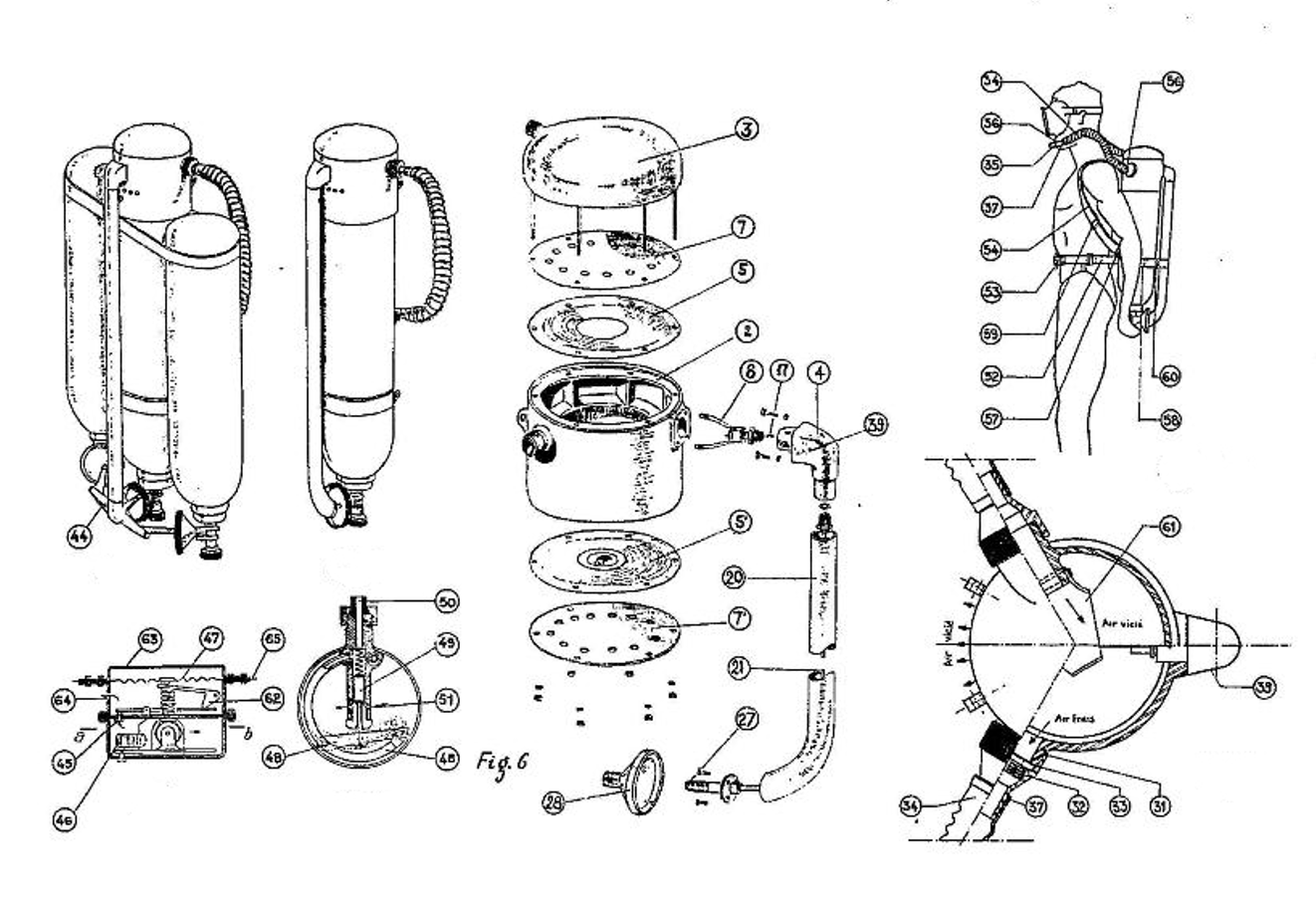
Esploso di un Poumondeau Dorsal
The Ventral Poumondeau
It is a small double tank system designed for quick gear and dives of medium depth (25 meters maximum, to wear in ventral position with valves positioned upwards. Light alloy bottles have a volume of 2 or 3 liters, with a filling pressure of 178 bar. With regards to its regulator, it is a single stage controlled by a flexible membrane of tubular shape. The system, instead of the classic corrugated one with cycle ring, presents only one hose with pendular circuit with duck-billed exhalation valve. This apparatus can be equipped with a waterproof pressure gauge with double reading, in the front to be read also by diver’s buddy and to be see by the diver’s himself.

Disegno di un Poumondeau Ventral
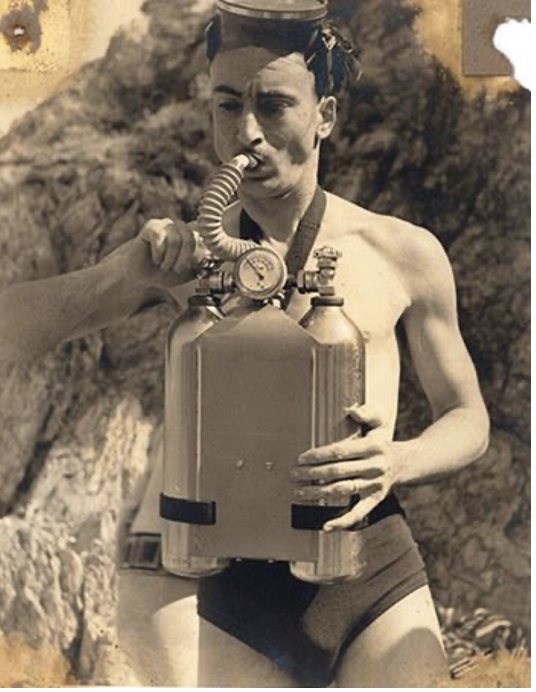
Georges Herail equipaggiato con un Poumondeau Ventral
The Junior Poumondeau
It is a system positioned in the back with two tanks and upward valves, with a single hose with pendular circuit. This will be the most sold model.
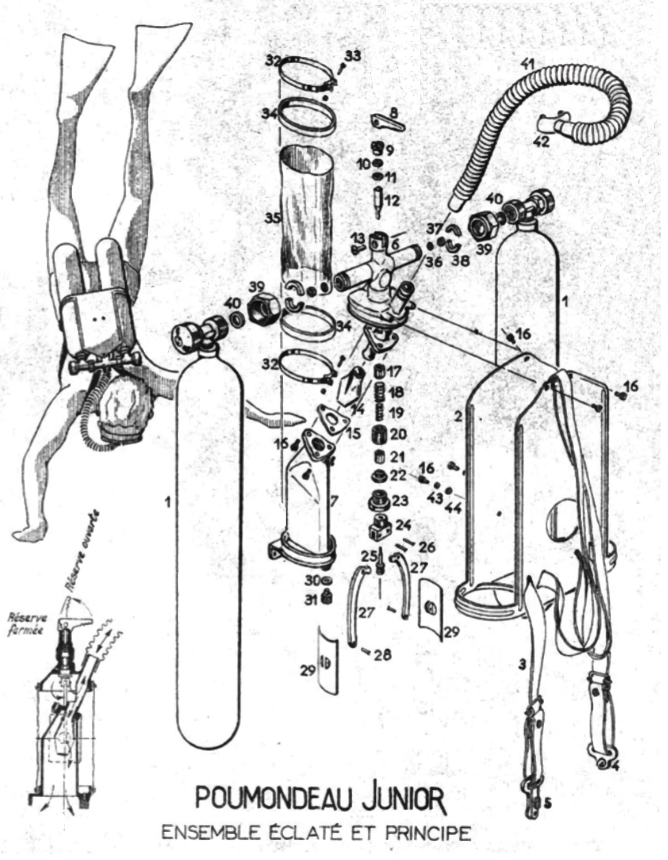
Esploso di un Poumondeau Junior
A fatal accident
In February of 1959, Herail is invited to make an inspection dive at the power plant dam of Saint-Lizier (Ariège). Dressed with a neoprene suit and one Poumondeau Ventral, Georges enters into water to make the first inspection downstream of the dam valve. Once this check ended, he dives a second time but, this time, upstream of the dam vale, at the level of the central stack of the valve. Despite being tied around the waist and holding a rope in his hand, he was brutally sucked in, so much so that he broke the rope that the assistants stubbornly continued to pull in an attempt to retrieve him. The alarm was immediately raised and, for three days, many divers from various clubs in the region took turns in the search, but it remained fruitless. Georges Herail’s body was never found. After this tragic death, his wife Claire continued to pay the yearly royalties for the patents registered by Georges, with the hope that competitor manufacturers of diving gear would take them over. This extreme sale attempt will be concluded in 1961 with the cancellation of the Poumondau brand by the Chamber of Trades and Crafts. This will end forever the adventure began a long time before by George Heiral and his Poumondeau.
The tests at GERS
Few months after Herail’s death, in July 1959, G.E.R.S. Commander made his report on the test made on the Poumondeau Ventral autonomous diving apparatus. Besides confirming its excellent manufacturing quality, this report glorifies the project originality and the general big compactness of the device; instead, he criticized the limited capacity of the two small bottles, as well as the supplied flow below twenty meters. The Commander writes his test report as follows: "Low-capacity diving apparatus with just enough performances, original design in more points with accurate manufacturing". He concludes that the system is not of interest for Navy, because of its too low capacity for the common diving use; however, he consents to classify it among the life-saving devices for which a good design would be suitable.
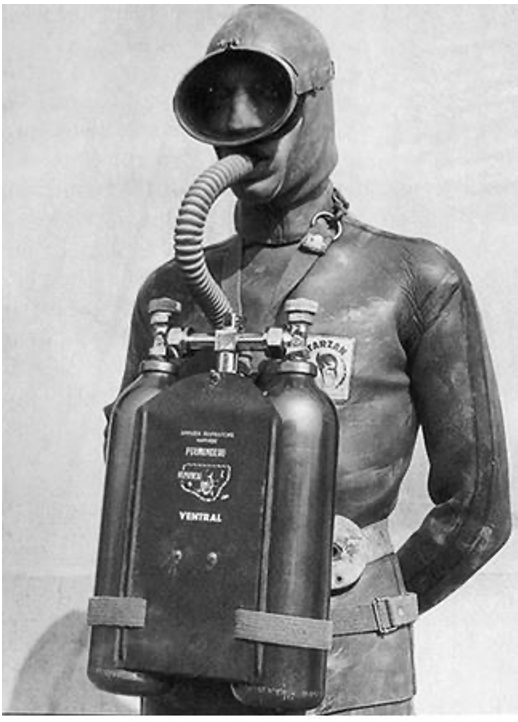
Poumondau Ventral during G.E.R.S. tests
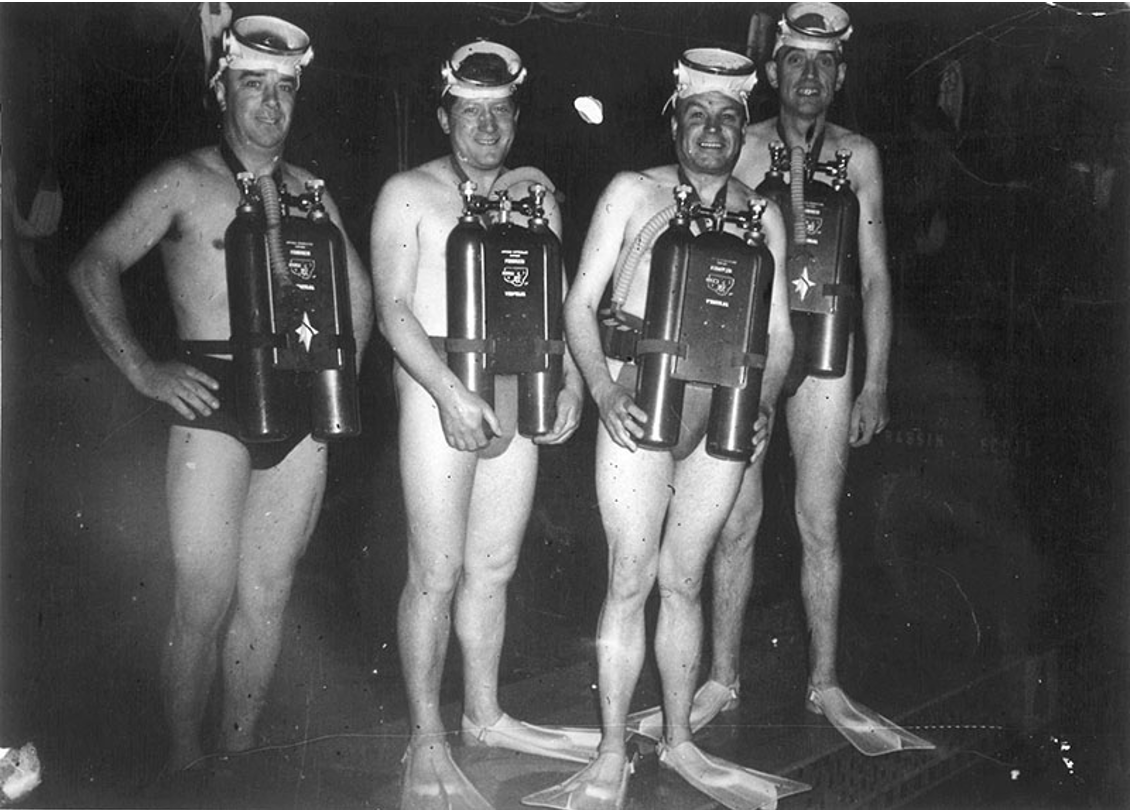
Divers geared with Poumondeau Ventral
____________________